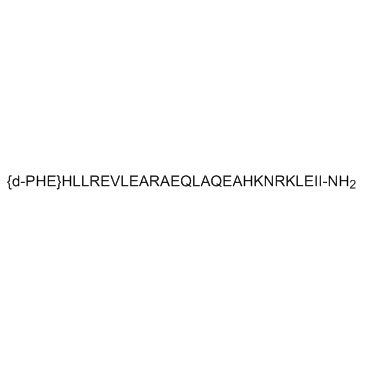170809-51-5
| Name | astressin |
|---|---|
| Synonyms |
Astressin
M.W. 3563.24 C161H269N49O42 [D-Phe12,Nle21,38,Glu30 ASTRESSIN TRIFLUOROACETATE SALT |
| Description | Astressin is a potent corticotropin releasing factor (CRF) antagonist. |
|---|---|
| Related Catalog | |
| In Vitro | Astressin has low affinity for the CRF binding protein and high affinity (Ki=2 nM) for the cloned pituitary receptor. Astressin shows high affinity for cloned human CRF-RA1 stably expressed in CHO cells and high potency to inhibit ACTH secretion[1]. |
| In Vivo | Astressin is significantly more potent than any previously tested antagonist in reducing hypophyseal corticotropin (ACTH) secretion in stressed or adrenalectomized rats. Low doses of astressin (30 μg and 100 μg per kg) administered i.v. still produce a significant decrease in ACTH levels at 45 and 90 min, respectively[1]. Astressin significantly reverses the anxiogenic-like response induced by both social stress and ICV rat/humanCRF (r/hCRF) on the elevated plus-maze, but fails to block the effects of r/hCRF-induced locomotor activity in a familiar environment[2]. Intracerebroventricular infusion of the peptide both 30 min before and 10 min after seizures decreases damage in some hippocampal cell fields by as much as 84%, a magnitude of protection greater than reported for other CRF antagonists against other models of necrotic neuronal injury. Astressin protects even if administered only 10 min following excitotoxin exposure[3]. |
| Animal Admin | Rats: Rat diet is supplemented with oranges, and their water contained 0.9% NaCl. They are equipped with indwelling jugular cannulae 48 h prior to the i.v. injection of either vehicle or astressin. Astressin is first diluted in sterile, distilled, apyrogenic water, and the pH is adjusted to 7.0. Further dilutions are made in 0.04 M phosphate buffer, pH 7.4, containing 0.1% bovine serum albumin and 0.01% ascorbic acid. Blood samples are obtained immediately before treatment, as well as 15-120 min later. Decanted plasma samples are frozen until assayed for ACTH concentrations[1]. |
| References |
| Molecular Formula | C161H269N49O42 |
|---|---|
| Molecular Weight | 3563.16000 |
| Exact Mass | 3561.04000 |
| PSA | 1489.66000 |
| LogP | 9.58910 |
| Storage condition | 2-8℃ |
| Personal Protective Equipment | Eyeshields;Gloves;type N95 (US);type P1 (EN143) respirator filter |
|---|---|
| RIDADR | NONH for all modes of transport |
